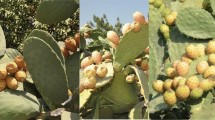Abstract
Minimally processed carrot products in finger or coin shapes are increasingly popular due to their convenience. The ‘BetaSweet’ carrot is a purple carrot with a high carotenoid and anthocyanin content, sweet taste, and juicy, crisp texture. This study was performed to investigate the changes in carotenoid, anthocyanin, and sugar of the sliced purple and an orange carrot during 4 weeks of cold storage at 2 °C or 4°C, simulating the transportation and marketing period. The purple carrot contained about 200–230 μg ·g−1 fresh weight total carotenoid and there was a slight decrease in the total carotenoid content during the 4-week period at both temperatures. Anthocyanin and total sugar contents were about 400–500 μg · g−1 and 70 mg· g−1 fresh weight, respectively and did not change significantly at either temperature. The orange carrots, tested for comparison, contained about 100 μg·g−1 total carotenoid and about 60 mg·g−1 fresh weight total sugar, and showed similar trend as the purple carrots during cold storage. Transfer from 2 °C to 4°C at 2 weeks did not show significant changes in any of the parameters. Sliced carrots had about 10% to 15% less carotenoid content as compared to whole carrots, probably due to wound damage and the oxidation process. The content of nutritional compounds of the purple carrots harvested during April and June was similar to that obtained throughout the season, demonstrating that consistent quality products could be produced. Our study confirmed that the changes in quality of sliced purple carrots were minimal or negligible during the commercial marketing period of 2 weeks, if the product was handled and displayed at 4°C or below.
Similar content being viewed by others
Literature Cited
Alasalvar, C., J.M. Grigor, D. Zhang, P.C. Quantick, and F. Shahidi. 2001. Comparison of volatiles, phenolics, sugars, antioxidant vitamins, and sensory quality of different of different colored carrots varieties. J. Agr. Food Chem. 49:1410–1416.
Alasalvar, C., M. Al-Farsi, P.C. Quantick, F. Shahidi, and R. Wiktorowics. 2005. Effect of chill storage and modified atmosphere packaging (MAP) on antioxidant activity, anthocyanins, carotenoids, phenolics and sensory quality of ready-to-eat shredded orange and purple carrots. Food Chem. 89:69–76.
Britton, G. 1991. Carotenoids, p. 473–518. In: P.M. Dey and J.B. Harborne (eds.). Methods in plant biochemistry. Academic Press, New York.
Chen, H.E., H.Y. Peng, and B.H. Chen. 1996. Stability of carotenoids and vitamin A during storage of carrot juice. Food Chem. 57:497–503.
Cisneros-Zevallos, L., M.E. Saltveit, and J.M. Krocha. 1995. Mechanism of surface discoloration of peeled (minimally processed) carrots during storage. J. Food Sci. 60:320–333.
Downham, A. and P. Collins. 2000. Colouring our foods in the last and next millennium. Intl. J. Food Sci. Technol. 35:5–22.
Ensminger, A. and J. Konlande. 1995. The concise encyclopedia of foods & nutrition. CRC Press, Boca Raton, FL, USA.
Fuleki, Y. and F.J. Francis. 1968. Quantitative methods for anthocyanins: Extraction and determination of total anthocyanin in cranberries. J. Food Sci. 33:72–77.
Glassgen, W.E., V. Wray, D. Strack, J.W. Metzger, and H.V. Seitz. 1992. Anthocyanins from cell suspension cultures of Daucus carota. Phytochemistry 31:1593–1601.
Hamilton, B.K., K.S. Yoo, and L.M. Pike. 1998. Changes in pungency of onions by soil type, sulphur nutrition and bulb maturity. Sci. Hort. 74:249–256.
Howard, L. and L.E. Griffin. 1993. Lignin formation and surface discoloration of minimally processed carrot sticks. J. Food Sci. 58:1065–1072.
Howard, L. and T. Dewi. 1996. Minimal processing and edible coating effects on composition and sensory quality of mini-peeled carrots. J. Food Sci. 61:643–646.
Lazcano, C. 1999. ’BetaSweet’ carrot: Production, flavor, nutritional attributes and market strategies. Ph.D. Dissertation. Texas A&M Univ., College Station, Texas, USA.
Prior, R.L., G. Cao, A. Martin, E. Sofic, J. McEwen, C. O’Brein, N. Lischner, M. Ehlenfeldt, W. Kalt, G. Krewer, and C.M. Mainland. 1998. Antioxidant capacity as influenced by total phenolic and anthocyanin content, maturity, and variety of Vaccinium species. J. Agr. Food Chem. 46:2686–2693.
Wrolstad, R.E. 2004. Anthocyanin pigments-bioactivity and coloring properties. J. Food Sci. 69:419–421.
Yen, Y.H., C.H. Shin, and C.H. Chang. 2008. Effect of adding ascorbic acid and glucose on the antioxidant properties during of dried carrots. Food Chem. 107:265–272.
Yeum, K.J. and R.M. Russell. 2002. Carotenoid bioabailability and bioconversion. Anal. Rev. Nutri. 22:483–504.
Author information
Authors and Affiliations
Corresponding author
Rights and permissions
About this article
Cite this article
Lee, E.J., Yoo, K.S. & Patil, B.S. Total carotenoid, anthocyanin, and sugar contents in sliced or whole purple (cv. Betasweet) and orange carrots during 4-week cold storage. Hortic. Environ. Biotechnol. 52, 402–407 (2011). https://doi.org/10.1007/s13580-011-0227-0
Received:
Accepted:
Published:
Issue Date:
DOI: https://doi.org/10.1007/s13580-011-0227-0




